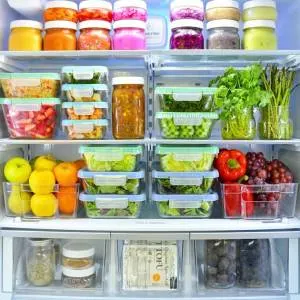 A vegetarian refrigerator should be good enough to keep your fruits and veggies fresh for days. You can choose an appliance, considering the measurement, cooling and storage capacity, door style, and smart features, regardless of the applications.
A vegetarian refrigerator should be good enough to keep your fruits and veggies fresh for days. You can choose an appliance, considering the measurement, cooling and storage capacity, door style, and smart features, regardless of the applications.
But these factors don’t change much whether you are a vegetarian or not. So, what is different when it comes to a refrigerator for vegetarians? What are the things to know about a vegetarian refrigerator?
It is mostly about how to prepare and produce the appliance. Then comes the storage. This article provides information about food (fruits and vegetables) safety and proper uses of a refrigerator for vegetarians.
Things to Know About Refrigerator for Vegetarian
Many of us would love to consider a refrigerator an all-purpose compartment, but safety cannot be ensured unless you know which items to keep in the fridge and which ones to leave out.
Ideal Produce for Refrigeration
Since the goal is to keep the items fresh while retaining their food value, these are the vegetables and fruits that should be stored in your fridge.
| Veggies | Fruits |
| Artichokes (including Jerusalem artichoke) | Apples |
| Asparagus | Blueberries, blackberries, currants, cranberries, strawberries, raspberries, and grapes |
| Beans (fresh, unshelled) and peas | Cherries |
| Beets | Figs |
| Belgian endive | Lychees |
| Broccoli and broccolini | Mangosteen |
| Sprouts and Brussels sprouts | Longan |
| Cabbage | Pomegranates |
| Carrots | Ripe citrus fruits |
| Cauliflower | |
| Celery, spinach, scallions, leafy greens, and salad leaves | |
| Peppers and chiles | |
| Corn | |
| Cucumber | |
| Eggplant | |
| Radishes and horseradish | |
| Fennels and herbs | |
| Mushrooms | |
| Summer squash |
Produce That Is Best Kept Out
Vegetables include potatoes, sweet potatoes, yuca (manioc, cassava), taro, tomatoes, and winter squash. Fruits include Asian pears, apricots, bananas, avocado, kiwis, pineapples, mangoes, guava, nectarines, melons, passion fruit, papayas, peaches, persimmons, plums, starfruit, and plantain.
Tips for Cleaning Fresh Produce
Vegetables and fruits are usually brought to you from long distances, and they may come in contact with harmful contaminants and bacteria along the way. Keeping them in the refrigerator without washing them at least once, you’ll only risk getting exposed to those contaminants.
You should wash the produce before storing them. No special cleaning compounds or commercial products are necessary. You can use regular water and a clean brush. Some items come with a waxy coating on them which needs to be rubbed off after you wash them.
Ensure the vegetables and fruits do not have too much moisture, as this could cause them to spoil quickly. It is best to dry each item right before putting them inside the refrigerator. If the vegetables come bagged and prewashed, you can store them without cleaning.
Tips for Cleaning Bins
You can find the majority of bacteria in your refrigerator bins, such as listeria, salmonella, and E. These germs can survive and multiply on cold surfaces, defying our traditional defense system.
Freezing temperatures may prevent the multiplication of both listeria and salmonella but cannot do so much to stop their survival. Cleaning the bins is thus an essential job. Follow these simple steps.
- Start by bringing everything out one by one.
- Remove all drawers and use warm water with dish detergent to wash them.
- Rinse them and use paper towels to dry them.
- Spray each drawer with a solution of 1 tbsp. of homemade sanitizer being mixed with 1 gallon of clean water.
- Leave them for 15-20 seconds and then dry them again using towels.
Guidelines for Refrigeration
Some of the accessories that you can use to ensure better preservation and organization of items include reusable plastic bags, stainless steel or lidded plastic containers.
- Avoid combining vegetables and fruits in the same container since some fruits, such as apples, pears, peaches, etc. give off ethylene and spoil vegetables, such as crucifers and lettuce.
- Keep all root vegetables (turnips, radishes, beets, etc.) together without their leaves.
- Put citrus fruits together.
- Salad leaves are good in a single container.
- Some produce needs to be kept tightly to provide room for other types.
- Dry vegetables can be sealed tightly in a container.
- Whole fruits should be kept in an unsealed container. Make an exception for soft berries.
Having learned which items are suitable and how to prepare them for storage, the next step is to set the internal temperature of your refrigerator at the right level.
Temperature Settings During Refrigeration
Speaking of an ideal temperature inside fridges, 34°F can be a good starting point. However, experts recommend different ways as you want to store veggies which generally require one of these four types of settings,
- Cold and moist (32-39°F for apples, carrots, broccoli, eggplants, and lettuce)
- Cool and moist (40-50°F)
- Cold and dry (32-39°F for onions and garlic)
- Warm and dry (50-60°F for pumpkins, hot peppers, sweet potatoes, and winter squash)
At this point, you have a few more things to know about vegetarian refrigerators. Have you heard of the crisper drawer in a refrigerator?
Having its own humidity control system, this section is ideal for your vegetables, as it provides the best cooling effect for fruits and vegetables that require high or low humidity.
Things to Know About the Crisper Section
It is basically an area consisting of one or more drawers that are sealed off. Most appliances have this section in their bottom. A dedicated humidity control unit allows for setting different levels of humidity which can be different from the main unit.
Some models feature multiple drawers and pre-set levels of humidity, while others allow you to adjust the different drawers to your desired humidity level. Adjustment of these levels can be difficult if you don’t know which products should be kept where. But once you do; it is easy.
Located in the back of each drawer is a little vent that closes when you set the humidity level to High. Basically, it seals that particular compartment. As you set the level to Low, that vent opens to let the trapped moisture out.
Finally, you need to know the difference between refrigeration and freezing. You can freeze almost all veggies without losing the nutrients and taste except the texture of fruits. Refrigerate items that you may eat anytime soon, and freeze produce that will be consumed much later.
